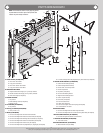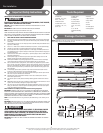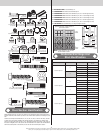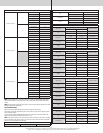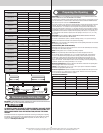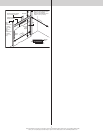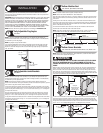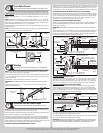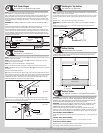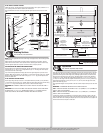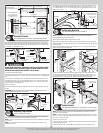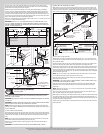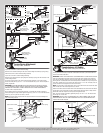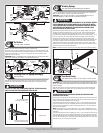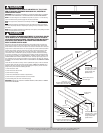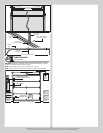
Please Do Not Return This Product To The Store. Contact your local Wayne-Dalton dealer. To find your local Wayne-Dalton dealer,
refer to your local yellow pages business listings or go to the Find a Dealer section online at www.Wayne-Dalton.com
Half Center Hinges
Tools: Power drill, 7/16” Socket driver, Tape measure
8
NOTE: If you don’t have half center hinges, then skip this step. Refer to Package Contents /
Parts Breakdown, to determine if you have half center hinges.
Using a tape measure, position the half center hinges equally spaced in between the center
hinges and equally spaced in between the center hinges and the graduated end hinges.
Position the holes of the lower hinge leaf onto the bottom section surface, as shown. Using
the half center hinge as a template, drill pilot holes, 1” deep into the bottom section using a
1/8” drill bit.
IMPORTANT: BE EXTREMELY CAREFUL NOT TO DRILL THRU THE SECTION. ONLY DRILL 1”
DEEP.
Attach the lower hinge leaf of the center hinge to the bottom section using (2) 1/4”-14 x 1”
lag screws. Repeat for other half center hinge(s). Set the bottom section aside.
Place the Intermediate I section face down on a couple of sawhorses or flat clean/ smooth
surface. Reference step Graduated End And Center Hinges and this step to attach the long
struts (if applicable) and hinges to the top rail of the sections in the same manner as was
done for the bottom section. Repeat the same process for the other Intermediate section(s) if
applicable, except top section.
(2) 1/4” - 14 x 1” Lag screws
Typical section
shown
Equally spaced
Half
center
hinge
Lower hinge leaf
Center
hinge
Long strut
(if applicable)
Top Fixtures
Tools: Power drill, 7/16” Socket driver
9
NOTE: If your door came with two top fixtures (A), then one top fixture and a short stem track
roller are required for each side.
NOTE: If your door came with four top fixtures (B), then two top fixtures and a long stem
track roller are required for each side.
NOTE: Refer to Door Section Identification / Parts Breakdown.
Place the top section face down on a couple of sawhorses or flat clean/ smooth surface.
NOTE: Depending on your door, refer to illustrations (A) or (B) to determine how to install the
top fixtures.
Follow the corresponding steps below:
(A): Starting on the left hand side, align the edge of the top fixture parallel to the top section
edge. Using the top fixture as a template, mark and pre-drill (3) 9/32” diameter holes through
the top section. Loosely attach the top fixture to the top section using (2) 1/4”-20 x 2-1/2”
carriage bolts and (2) 1/4-20 flange hex nuts. Insert a short stem track roller into the top
fixture slide. Repeat the same process for the right hand side.
(C) Left hand
top fixture
Short stem
track roller
(2) 1/4” - 20
Flange hex nuts
(2) 1/4” - 20 x 2 1/2”
Carriage bolts
Top section
(B): Position the second top fixture next to the first installed top fixture and loosely attach
it with (2) 1/4–14 x 1” lag screws. Insert a long stem track roller into the top fixture slides.
Repeat the same process for the right hand side.
(2) Top
fixtures
Long stem
track roller
(2) 1/4” - 14 x 1”
Lag screws
(D) Left hand
top fixture
Top section
Strutting For Top Section
Tools: Power drill, 7/16” Socket driver
10
NOTE: Refer to the Door Section Identification and Strut Identification, to determine if the top
section requires a short strut to be installed.
Lay the short strut onto the top rail of the top section. Position the top of the strut 3/4” down
from the top edge of the top section. Center the short strut from side to side on the section
surface.
Drill pilot holes, 1” deep into the top section using a 1/8” drill bit.
IMPORTANT: BE EXTREMELY CAREFUL NOT TO DRILL THRU THE SECTION. ONLY DRILL 1”
DEEP.
Attach the strut using (2) 1/4”-14 x 1” lag screws at each on each end and center stile
(aligned with hinges) locations.
Top section
Typical top
fixture
1/4” - 14 x 1”
Lag screws
Short strut
3/4”
Bottom Section
Tools: Level, Wooden shims (if necessary)
11
Center the bottom section in the door opening. Level the section using wooden shims (if
necessary) under the bottom section.
Weather seal
Level
Bottom section
Wooden shims
(If necessary)
Vertical Tracks
Tools: Power Drill, 3/16” Drill bit, 7/16” Socket driver, Tape measure,
12
IMPORTANT: IF YOUR DOOR IS TO BE INSTALLED PRIOR TO A FINISHING CONSTRUCTION
OF THE BUILDING’S FLOOR, THE VERTICAL TRACKS AND THE DOOR BOTTOM SECTION
ASSEMBLY SHOULD BE INSTALLED SUCH THAT WHEN THE FLOOR IS CONSTRUCTED, NO
DOOR OR TRACK PARTS ARE TRAPPED IN THE FLOOR CONSTRUCTION.
IMPORTANT: THE TOPS OF THE VERTICAL TRACKS MUST BE LEVEL FROM SIDE TO SIDE.
IF THE BOTTOM SECTION WAS SHIMMED TO LEVEL IT, THE VERTICAL TRACK ON THE
SHIMMED SIDE MUST BE RAISED THE HEIGHT OF THE SHIM.
Position the left hand vertical track assembly / wall angle track assembly over the track
rollers of the bottom section. Make sure the counterbalance lift cable is located between the
track rollers and the door jamb. Drill 3/16” pilot holes into the door jamb for the lag screws.
FOR FLAG ANGLE TRACK ASSEMBLIES:
Loosely fasten jamb brackets and flag angle to the jamb using 5/16” x 1-5/8” lag screws, as
shown.
FOR WALL ANGLE TRACK ASSEMBLY:
Loosely fasten wall angle to the jamb using 5/16” x 1-5/8” lag screws, as shown.
IF YOU HAVE 2” VERTICAL TRACKS:
Tighten lag screws, securing the bottom jamb bracket/bottom slot to jamb, maintain 3/8” to
5/8” spacing, between the bottom section and vertical track.
10



